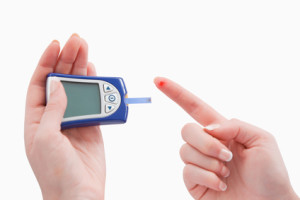Exercise is important in everyone’s life. However it is particularly important if you have diabetes. Exercise can help control blood sugar levels, maintain desirable weight, increase circulation, and reduce the risk of cardiovascular disease.
 Exercise Guidelines
Exercise Guidelines
- Obtain a medical release from your healthcare provider prior to beginning or modifying an exercise program.
- Check your blood glucose level prior to exercise. Do not initiate exercise if blood glucose levels are less than 100 mg/dl or greater than 250mg/dl. In addition the physician should establish the your acceptable blood glucose upper limit allowable for exercise.
- Begin with entry exercise levels. Gradual progression allows for less blood sugar fluctuation and for changes in medication and meal planning. A medical fitness professional can help you with this.
- Consistency is paramount. It is recommended to exercise at the same time of day and at similar intensities, durations and frequencies. Consistency results in less fluctuation of blood sugar
- Blood sugar monitoring should be performed more often than normal when first starting an exercise program or when changes are made to the program.
- Avoid isometric exercises or any exercises that results in a sustained increase in systolic blood pressure. This is of particular concern for those with microvascular disease. Sustained increase in systolic BP can result in retinal hemorrhage or excess protein in urine.
- Keep your physician informed of your current exercise program
- To achieve better health and quality of life, people with diabetes should be encouraged to participate in physical activity regularly.
Benefits of Exercise
 Lower blood sugar levels
Lower blood sugar levels- Help reverse the insulin resistance that is associated with excess body fat T2DM
- Delay and prevent the development of arthrosclerosis
- Modify body composition and reduce weight when combined with a reduction in caloric intake.
- Increase circulation to all parts of the body
- Reduce depression & stress
Risks of Exercise
Hypoglycemia can occur during or after exercise. Exercise induces glucose utilization, and, therefore, generally a reduction in blood glucose levels, which means that during exercise your client’s blood glucose levels may drop too much. If blood glucose level prior to exercise is less than 100 mg/dl, 15 grams of Cho need to be consumed and you should wait 15 minutes.
Injection or infusion site for the insulin is important. Insulin is absorbed more rapidly when administered to an area close to working muscles.
 Dehydration is a concern when you have diabetics. People with diabetes have a greater risk of dehydration due to increase fluid requirement of kidneys and urine output needed to flush excess glucose from body. Make sure you drink 20 oz of water 2 hours before exercise.
Dehydration is a concern when you have diabetics. People with diabetes have a greater risk of dehydration due to increase fluid requirement of kidneys and urine output needed to flush excess glucose from body. Make sure you drink 20 oz of water 2 hours before exercise.
People who use insulin should not exercise alone. Avoid exercise at the time of peak insulin.
Medical fitness professional recognize the symptoms of hypoglycemia and know how to treat it. – 4oz fruit juice, 8 oz sport drink, ½ banana, 1 fig newton
- Abnormal gait
- Clicking feet when running (kicking feet together, stumbling)
- Lack of balance
- Fatigue, “puniness”
- Confusion
- Seeing stars
- Chills
- Buzzing in ears
- Increased heart rate
- Irritability
- Reduction in power (cannot perform at usual level)
- Heart palpitations
Exercise Program Development
The American Diabetes Association and the American Heart Association support the Physical Activity Guidelines for Americans (US Dept Health & Human Services 2009) for individuals with diabetes who do not have medical contradictions. In addition, in 2010 the American College of Sports Medicine (ACSM) and the ADA issued guidelines for T2DM which call for both aerobic and resistance training exercise.
 Aerobic exercise guidelines – at least 3 times a week, preferably 5 times a week 40%-60% of Vo2max, greater health benefits can be achieved at >60% of Vo2max. Aerobic activity alone cannot provide the full benefit of exercise to diabetics. Recent studies has shown that resistance training is perhaps more important than aerobic training in managing diabetes. Much of the effect appears to be due to the metabolic adaptions of skeletal muscle.
Aerobic exercise guidelines – at least 3 times a week, preferably 5 times a week 40%-60% of Vo2max, greater health benefits can be achieved at >60% of Vo2max. Aerobic activity alone cannot provide the full benefit of exercise to diabetics. Recent studies has shown that resistance training is perhaps more important than aerobic training in managing diabetes. Much of the effect appears to be due to the metabolic adaptions of skeletal muscle.
Resistance training guidelines – at least 2 times per week on nonconsecutive days and progress to 3 times per week, machines and free weights can be used; both have shown equivalent benefits in blood glucose control. 5-10 resistance training exercise of major muscle groups is appropriate. Strength training improves muscular strength and endurance, functional ability, bone health and balance
Due to potentially complex physical limitations of diabetic client, the ACSM and ADA recommend that clients always be supervised by a qualified medical fitness trainer when engaged in resistance training. This will help ensure optimal blood glucose management and other health benefits while minimizing the risk of injury.
Appropriately trained medical fitness professionals understand the types of diabetes and the role of blood glucose monitoring, how to respond to glycemic complications, and nutrition. They understand the needs of the diabetic population, including pregnant woman, athletes and older adults. Medical fitness professionals have acquired the tools and strategies to improve the physical fitness of an individual with diabetes. They can help with weight loss and can work with your healthcare provider(s) to maximize the care of your diabetes.
Click here to find a medical fitness professional near you.
